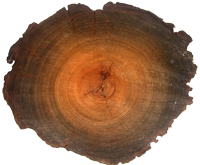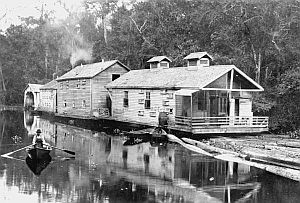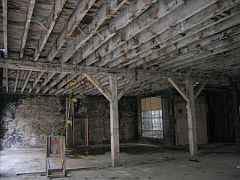Recovered Wood is beauty, quality, strength, and our history
When looking for the wood to use on your beautiful project, virgin Cypress
and Longleaf Pine must be seriously considered. These are two of the major
woods that built America. Whether we’re recovering them from an old river or
an old building, they are truly “Wood, the way it used to be”.
If you’re an architect, fine homebuilder, cabinetmaker or
rare woods purist, our virgin Cypress and Longleaf Pine
will give your next project exceptional beauty, strength and
a captivating story that dates back to the days of
Columbus’s discovery of America. The allure that our
recovered cypress and longleaf pine provide is beyond
compare.

Dense growth rings in a sinker cypress log
Krantz Recovered Woods’ products are all environmentally
sound, created by recycling a resource lost underwater or
used in a building years ago and is now ready to live again
in your project. This recovered virgin growth wood is
“antique quality” that has not been available in any
significant amount for almost a century. The virgin growth
lumber we offer displays a fineness of grain, pattern and
density that woodworkers will instantly recognizable as
“antique” quality. Your designs will take on a whole new
look with these rare lumber items. Our woods have the same
fine grain and texture as the antiques of 100 years ago
because they’re from the same forests. Your designs
will take on a whole new look with these rare lumber items.
Whether we’re recovering them from an old river or an old
building, they are truly “Wood, the way it used to be.”
Interest in sustainable, green building practices is greater than ever.
Whether concerned about allergies, energy costs, old-growth forests, or
durability and long-term value, homeowners and builders are looking for
ways to ensure that their homes are healthy, safe, beautiful, and efficient.
The sinker cypress and longleaf pine story
Grown in a thick forest canopy while competing for limited nutrients and sunlight,
these virgin trees matured very slowly, accumulating up to 15 to 50 rings per inch
in cypress and 6 to 20 rings in longleaf pine. These environmental factors resulted
in the development of finely grained woods of exceptional quality and beauty. By contrast,
today’s second growth trees average only 3 to 5 rings per inch.

Late 1800’s Cypress logging camp
Throughout the late 1800’s and early 1900’s, logging companies used America’s
waterways to transport their lumber to the mills downstream. These logs were
tied into rafts and floated to the lumber mills for processing, where most were
used to build the great cities of the Industrial Revolution. The photo at the
top of this webpage was taken around 1900 on a south Louisiana river; the raft
is half a mile of cypress and pine logs on their way to the sawmills. A few of
these logs broke loose from the raft or became waterlogged in the sawmill
holding ponds. Eventually they settled to the bottom where they are preserved in the
silted waters and forgotten for over 100 years. These sunken logs have remained at
the bottom of lakes and rivers untouched and perfectly preserved. These old logs
are known as “sinkers”.
With America’s old-growth forests nearly depleted, it wasn’t until recently that
Krantz Recovered Woods discovered these lost sinkers and devised methods for the
recovery and drying of this irreplaceable 300 - 1200 year old virgin old-growth
timber. Using specially trained log recovery experts, America’s waterways are
again yielding the quality timber of yesteryear. We make these lost treasures
available to people who want a touch of history, distinction, and environmental
responsibility in their next project. Every tree which is brought up from the
depths effectively saves living trees from being cut down.
Krantz Recovered Woods sinker Cypress specs
Krantz Recovered Woods sinker Longleaf Pine specs
The reclaimed longleaf pine story

Early 20th century warehouse interior beams
These are the virgin longleaf pine trees that did make it to the sawmill and
were then sawn into lumber and beams. When America’s beautiful old (pre-1925)
buildings and structures are dismantled, we take great care to lovingly reclaim
the beams and lumber so they can be used again. With nail holes and bolt holes
and other marks of a century or more of use, this wood is part of our national history.
Whether it’s a New Orleans cotton trading exchange building from 1880 or a barn from
Arkansas or massive beams from a wharf or bridge, these are the actual woods our
ancestors used. They have renewed America’s love affair with
“Wood, the way it used to be”.
Krantz Recovered Woods reclaimed Longleaf Pine specs
Additional Information
The USDA Forest Research Service has very thorough pamphlets on both cypress
(PDF)
and longleaf pine (PDF).
To keep your wood looking new (or to stain it), you might check out the USDA Forest Products
Laboratory website, it has some great wood finishing articles (PDF format):
Cypress technical information
Specific Gravity (>12% moisture content): .46
Density (lbs./ft.3): 31.4
Static Bending (Dry Lumber)
- modulus of rupture (lbs./in.2): 10,600
- modulus of elasticity (million psi): 1.44
- work to maximum load (in.-lbs./ft.3): 8.2
Impact Bending (Dry Lumber)
- height of drop causing complete failure (in.): 24
Compression Parallel to Grain (Dry Lumber)
- maximum crushing strength (lbs./in.2): 6,360
Compression Perpendicular to Grain (Dry Lumber)
- fiber stress at proportional limit (lbs./in.2): 730
Tension Perpendicular to Grain (Dry Lumber)
- maximum tensile strength (lbs./in.2): 270
Shear Parallel to Grain (Dry Lumber)
- maximum shearing strength (lbs./in.2): 1000
Side Hardness
- load required to embed a .444 ball to 1/2 diameter (lbs.): 510
Flame Spread Rating: 145-150
Source: Wood Handbook, USDA Agriculture Handbook 72